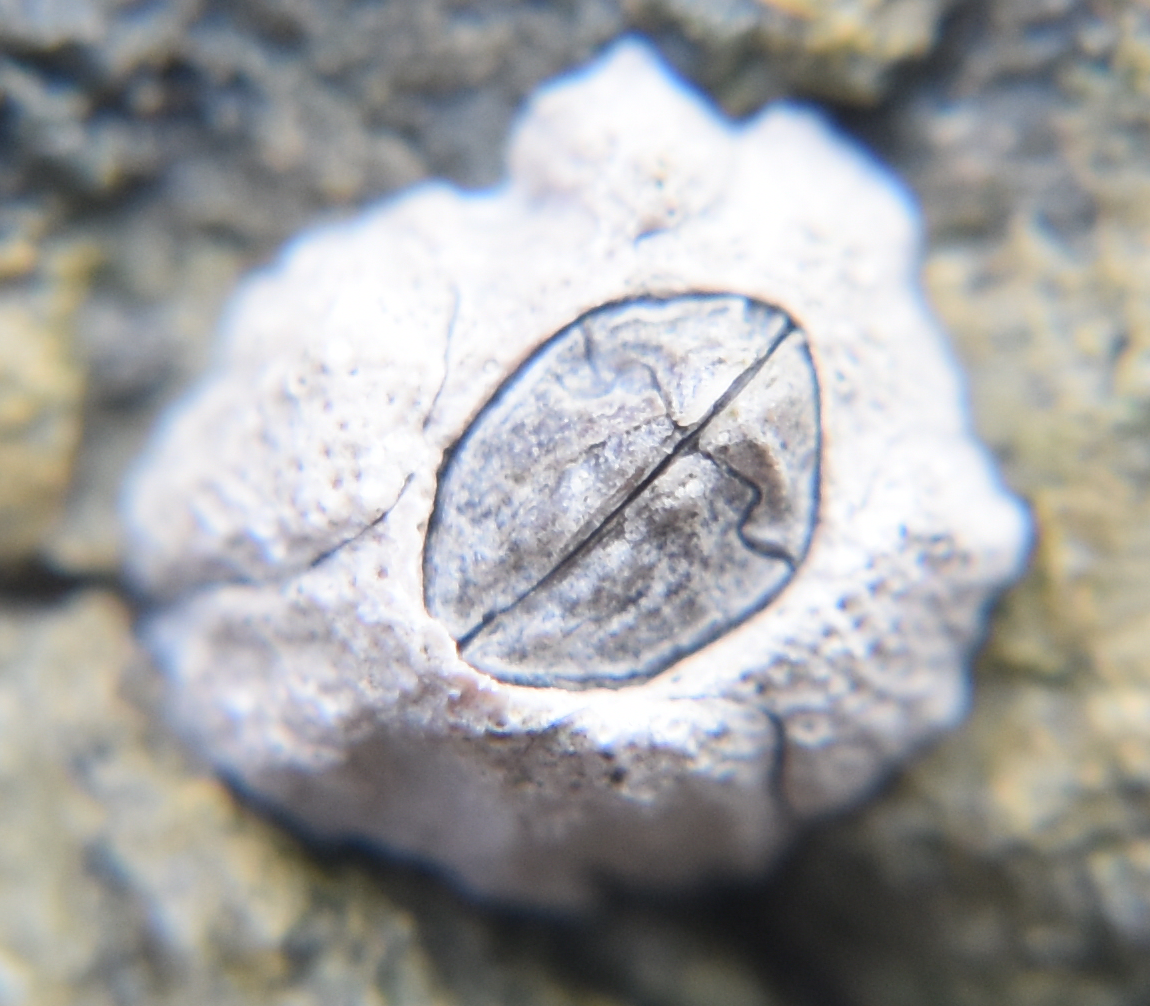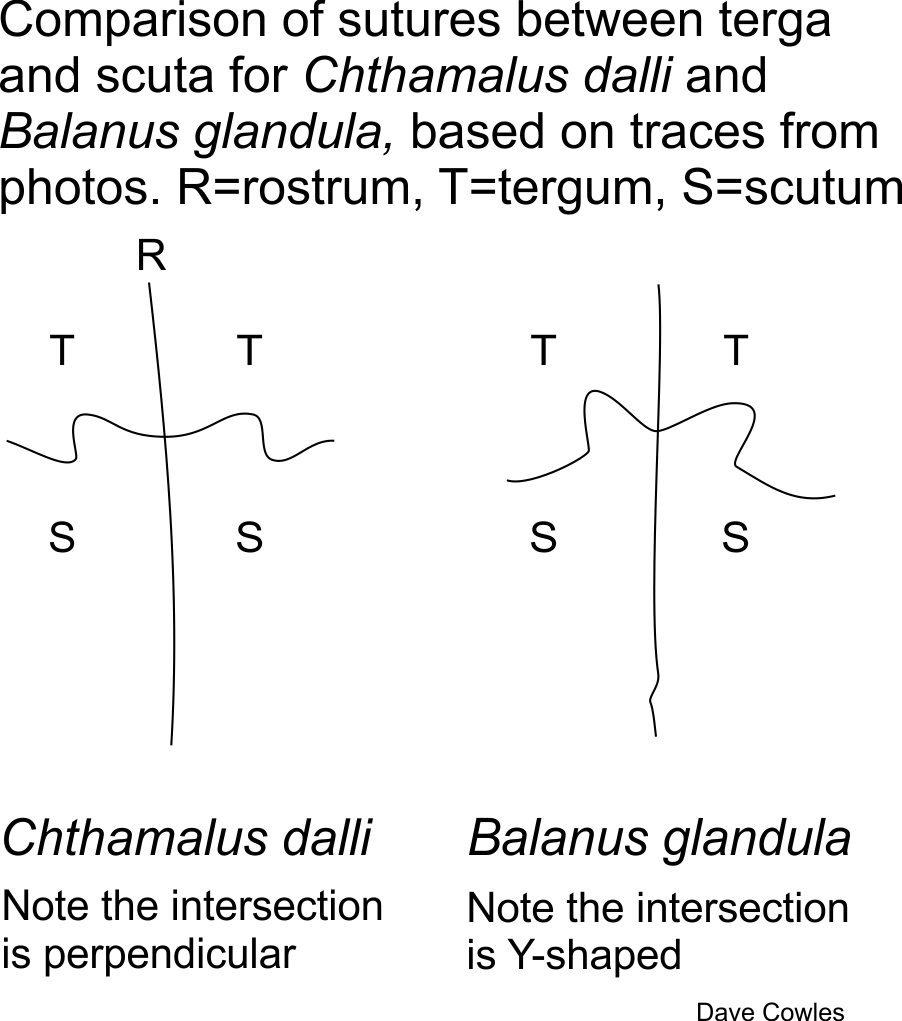Chthamalus dalli Pilsbry, 1916Common name(s): Brown buckshot barnacle, Little brown barnacle |
|
| Synonyms: |  |
|
Phylum Arthropoda
Subphylum Crustacea
Class Maxillopoda
Subclass Thecostraca
Superorder Thoracica
Order Sessilia
Superfamiy
Chthamaloidea
Family Chthamalidae
|
|
| Chthamalus dalli, about 0.5 cm diameter, on a high intertidal rock at Sares Head. Rostrum and tergal plates are at the top right, carina and scutal plates are at bottom left. Note that the rostrolateral plate adjacent to the rostrum overlaps the rostrum. | |
| (Photo by: Dave Cowles, July 2020) | |
Description: This very small acorn barnacle is found almost exclusively in the very high intertidal. It is the only local barnacle in which the plate adjacent to the rostrum overlaps the rostrum (for this reason that plate is called a rostrolateral instead of carinolateral 1). Since the carina is also overlapped by the adjacent plate (the carinolateral plate), both the rostrum and the carina are overlapped by the adjacent plate. The suture between the terga and the scuta is perpendicular to the suture between the two terga and the suture between the two scuta, so that the intersection looks like a cross (see photo above). Further to the side, however, the suture becomes sinuous (see photo above). Diameter not more than 1 cm, usually 0.5 cm or less. Color often brownish, sometimes gray.
How to Distinguish from Similar Species: This is the only local acorn barnacle species in which the lateral plates overlap both the rostrum and the carina. Also, its small size and high intertidal location are shared only by Balanus glandula. Chthamalus dalli can be distinguished from high-living Balanus glandula because B. glandula's rostrum overlaps the adjacent (carinolateral 1) plate, Balanus glandula often grows to larger than 1 cm diameter, and because although both species have a sinuous line in the interface between the terga and scuta, the intersection is perpendicular (cross-like) in Chamalus dalli but it is not in Balanus glandula (see diagram below). Another Chamalus species, C. fissus, lives south of San Francisco and must be dissected to distinguish it from C. dalli.
Geographical Range: Unalaska Island, Alaska to San Diego California
Depth Range: Very high intertidal
Habitat: Attached to rocks, sometimes to crustaceans
Biology/Natural
History: This species
can withstand desiccation better than most other barnacle species, so
it
is found higher in the intertidal zone than nearly any other barnacle
species.
However, on our coast Balanus
glandula
can often be found virtually as high, so the two species may be mixed
together
at the very highest intertidal zones. At slightly lower intertidal
elevations Balanus
glandula quickly outcompetes and pushes Chamalus
dalli off the rocks. C. dalli
may be parasitized by the epicaridean isopod Cryptothir
balani, which prevents the individual from reproducing.
Since barnacles
have internal fertilization in which sperm is transferred by a long
penis,
individuals living over about 5 cm from another individual of the same
species probably cannot reach them to cross-fertilize but may fertilize
themselves. However, Wares and Castaneda (2005) reported that this
species
appears to be panmictic (freely interbreeding) throughout its range,
which
is not often expected for a species such as this which can only breed
with
adjacent individuals. Perhaps it has a long larval life so the larvae
can
disperse broadly up and down the coast. Unlike Balanus
glandula, this species does not crowd together so closely
that it
grows into a "high rise" form.
| Return to: | |||
| Main Page | Alphabetic Index | Systematic Index | Glossary |
References:
Dichotomous Keys:Carlton, 2007
Kozloff, 1987, 1996
General References:
Kozloff,
1993
Morris
et al., 1980
Ricketts
et al., 1985
Sept,
1999
Scientific Articles:
Wares, J.P, and A.E. Castaneda, 2005. Geographic range in Chthamalus
along the west coast of North America. Journal of the Marine Biological
Association of the United Kingdom 85:2 pp. 327-331. doi https://doi.org/10.1017/S0025315405011227h
Web sites:
General Notes and
Observations: Locations, abundances,
unusual behaviors:
Authors and Editors
of Page:
Dave Cowles (2018): Created original page
CSS coding for page developed by Jonathan Cowles
Salish Sea Invertebrates web site provided courtesy of Walla
Walla University
